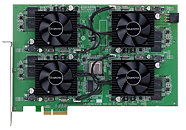
Toshiba Intros the First Glasses-free 3D Laptop Able to Simultaneously Display 2D, 3D
Toshiba Corporation today unveiled "dynabook Qosmio T851/D8CR", the world's first glasses-free 3D notebook PC able to display 3D and 2D content at the same time on one screen. The new PC will be available in the Japanese market from late July.
Dynabook Qosmio T851/D8CR employs Toshiba's distinctive 3D Window technology to realize the world's first glasses-free 3D portable PC able to simultaneously display 3D and 2D content in separate windows in a single screen. Users can watch high-quality 3D images or enjoy 3D games in one window without any need for wearing dedicated glasses or installing a dedicated panel over the display, while at the same time working, browsing the internet or sending e-mail in another window.
Dynabook Qosmio T851/D8CR employs Toshiba's distinctive 3D Window technology to realize the world's first glasses-free 3D portable PC able to simultaneously display 3D and 2D content in separate windows in a single screen. Users can watch high-quality 3D images or enjoy 3D games in one window without any need for wearing dedicated glasses or installing a dedicated panel over the display, while at the same time working, browsing the internet or sending e-mail in another window.




